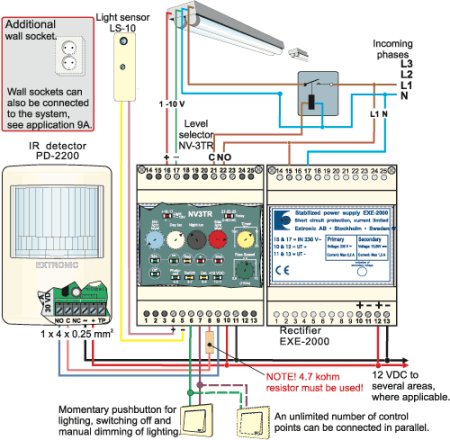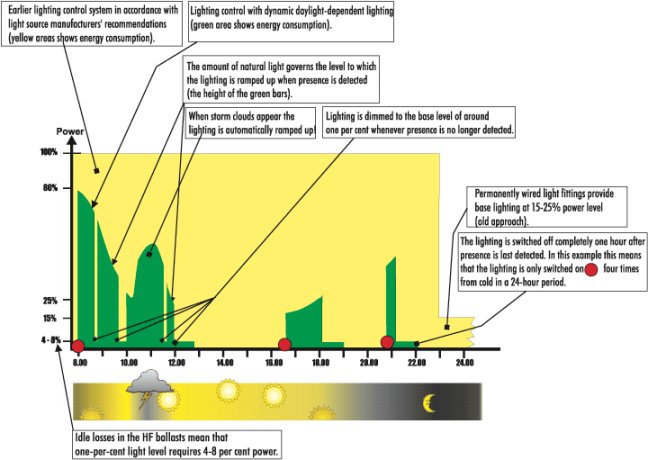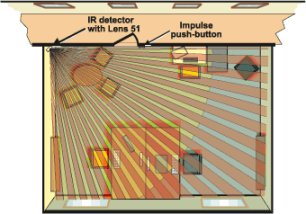9C. Large office with IR detector
Dimmable HF ballasts, daylight-dependent lighting and On/Off logic
| The premises
In office rooms and other small rooms it is usually hard to justify investment in presence-controlled lighting on a purely financial basis. The investment cost of existing technology is too high in relation to the possible reduced energy consumption (saving). Detection in this type of premises uses IR detectors equipped with a high-resolution lens. To improve the results and increase the saving, wall sockets can also be connected to the presence control. This means that fittings for desk lights, point lighting, monitors etc. can be presence-controlled. Other benefits such as environmental and convenience benefits can often be entered in a ‘calculation’, which can lead to justification of the investment. Future increased energy prices and more advanced and cheaper technology can also make it profitable to invest in presence-controlled lighting in office rooms. In offices it must be possible to switch on lighting when needed (room has natural lighting from windows) and switch lighting off when leaving the room. When special activities take place it should be possible to dim the lighting manually to the required level. It would be an infringement of personal freedom to set a light level that cannot be changed. Different people have different lighting needs for different activities. NV-3TR provides the possibility to regulate the light level manually. Light sources The light fittings have dimmable HF ballasts with analogue control (1–10 V). Detector placement An IR detector with a number 51 lens is used in office space. This gives the maximum possible resolution and hence the ability to detect small movements. |
Control system
To exploit the hidden savings potential available in all areas that have natural lighting, the installation should include an on/off logic module that prevents the lighting from being switched on when someone enters. All activities may not require artificial lighting in addition to the available natural light, so personal needs should decide when lighting is switched on. This means that the lighting is switched on and off in the usual way using a pushbutton. The detector only comes into action and dims the lighting to the base level (one per cent) after the set time (3–5 min.) when someone forgets to switch a light off. To use this function a 4.7 kohm resistor must be connected between the IR detector and the level selector. The lighting can be adjusted to suit the natural light (daylight-dependent light) by means of the LS-10 light sensor. The dimmable light fittings with HF ballasts are regulated by analogue control (1–10 V). The light intensity can also be adjusted manually by holding in the pushbutton. Whenever the lighting is switched on the system reverts to the set light level for daylight-dependent lighting. The dynamic system uses light fittings with dimmable HF ballasts, presence detection, level selection and a light sensor.
|
||||||||||||||||||
 |
|||||||||||||||||||
|
Information for current budget
|
|
||||||||||||||||||
 |
|||||||||||||||||||








